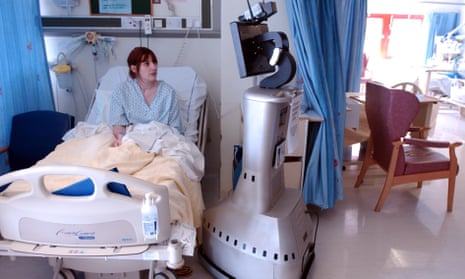Robots could soon help hospital patients eat their meals, diagnose serious illnesses and even help people recover from operations, in an artificial intelligence revolution in the NHS, a new report predicts.
Machines could take over a wide range of tasks currently done by doctors, nurses, healthcare assistants and administrative staff, according to a leading thinktank.
Widespread adoption of AI and the NHS embracing “full automation” could free up as much as £12.5bn a year worth of staff time for them to spend interacting with patients.
“Given the scale of productivity savings required in health and care – and the shortage of frontline staff – automation presents a significant opportunity to improve both the efficiency and the quality of care in the NHS,” says a new report released on Monday by the Institute for Public Policy Research (IPPR) and Lord Darzi, the eminent surgeon and ex-health minister.
“Bedside robots” could help patients consume food and drink and move around their ward, and even help with exercises as part of their rehabilitation from surgery, it says. In addition, “someone arriving at hospital may begin by undergoing digital triage in an automated assessment suite. AI-based systems, include machine-learning algorithms, would be used to make more accurate diagnoses of diseases such as pneumonia, breast and skin cancers, eye diseases and heart conditions.”
Digital technology could also take over the communication of patients’ notes, booking of appointments and processing of prescriptions.
However, the report sought to allay fears that an AI-powered NHS could lead to a significant loss of jobs among its 1.3 million-strong workforce in England. Unlike other settings, machines would work alongside human beings, not replace them, so patients would benefit, it says.
The report, part of a major piece of research into how to make the NHS sustainable as it approaches its 70th birthday on 5 July, states: “Unlike many industries, where there are fears that automation will result in mass unemployment, in health and care automation will primarily complement human skills and talents, by reducing the burden of administrative tasks – communicating medical notes, booking appointments, processing prescriptions – whilst freeing up time for clinical decision making and caring.”
Hospital bosses are divided over how plausible the IPPR’s vision of a future AI-driven NHS is and the scope for robots taking over tasks currently done by nurses and other staff.
“It is realistic that significant elements of patient care could be improved by robotics and artificial intelligence. However we must never forget the fundamental importance of human care, compassion, empathy and even the importance of a gentle, physical, human touch. For it to be welcome health services will have to sensitively blend new technologies with old-fashioned care,” said Andrew Foster, chief executive of the Wrightington, Wigan and Leigh NHS trust, who was also the Department of Health’s director of human resources for the NHS from 2001 to 2006.
Tracy Bullock, chief executive of Mid Cheshire Hospitals trust, voiced similar caution. “When a patient is being fed, you are not just feeding them, you are assessing their alertness, emotional state, ability to engage, skin condition, respiratory rate and so on. I’m not sure AI can do that as the algorithms to enable it would be too complex,” she said.
“Would there be redundancies? I would hope not as we are woefully short of staff. But if the savings do not come from staff where are they coming from? I’m sure there will be some from quicker treatments and other efficiencies. But £12bn?”
Foster, however, doubted the NHS could afford to reduce its workforce as a result of the adoption of AI. “We currently have at least 100,000 vacancies in the NHS with demand rising all the time. I think that redundant NHS staff is a long way from being a significant concern,” he said.
Meanwhile, hospitals are having to keep using out of date scanners that should have been replaced up to 17 years ago as a result of the NHS’s cash crisis, new figures reveal.
Information released by hospitals in England under freedom of information laws on Monday show widespread continued use of very old X-ray machines as well as CT, MRI and ultrasound scanners.
Of the 892 X-ray machines in use in hospitals that were more than 10 years old, 139 were past their replacement date, according to figures obtained by Jonathan Ashworth, the shadow health secretary.
Of 295 ultrasound machines in use for at least a decade 134 should already have been replaced, as should 10 of the 46 MRI scanners and 10 of the 45 CT scanners which are that age.
One X-ray machine dating back to 1984 is still in use in a hospital in Leeds, while an ultrasound machine which came into service in 1992 is also still in use in Oxford. In South Tees an ultrasound scanner that should have been replaced in 2001 is still being used, as is an MRI scanner at the Royal Free hospital in London, the research found.
“Eight years of Tory austerity funding imposed on our NHS have led to a backlog of £5bn of repairs to crumbling hospitals and old equipment that in some cases is decades past its sell-by date,” said Ashworth. Hospitals have struggled to afford to replace out of date equipment in recent years as a result of the government using £3.8bn of NHS capital funding, which pays for repairs, new buildings and buying new equipment, to help pay for hospitals’ running costs.
Recent research showed that the UK has only 9.5 CT scanners per one million of population, compared with the Organisation for Economic Co-operation and Development average of 26. Similarly, the NHS has only 7.2 scanners per million people, whereas the OECD average is 16.
